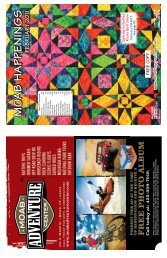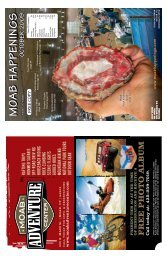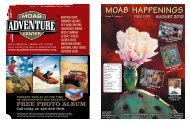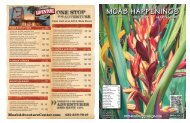December 2011 - Moab Happenings
December 2011 - Moab Happenings
December 2011 - Moab Happenings
Create successful ePaper yourself
Turn your PDF publications into a flip-book with our unique Google optimized e-Paper software.
www.moabhappenings.com<br />
Aztec Butte – Clues To An Ancient Culture<br />
Island In The Sky, with an average elevation of<br />
6100 feet, is the highest portion of Canyonlands National<br />
Park. Situated like a desert island, this sheer-walled plateau<br />
is surrounded by a far-reaching, isolated landscape,<br />
which drops precipitously down to the surging waters of<br />
the Colorado and Green Rivers. On a clear day, a person<br />
can cast his vision almost 100 miles across a tangled web<br />
of canyons, mesas, buttes, fins and spires – a wondrous<br />
horizon-to-horizon view climaxed by three distinct<br />
mountain ranges – the La Sals to the east, the Abajos to the<br />
south and the Henry Mountains to the west.<br />
Somewhere in time - many centuries ago - groups of<br />
ancestral Puebloans (formerly known as Anasazi) lived<br />
within the boundaries of the park. Pressured by the growing<br />
populations around Mesa Verde, they had migrated to Utah’s<br />
Canyonlands searching for more suitable land to grow<br />
their crops of corn, squash and beans. By 1200 A.D., these<br />
early farmers had<br />
settled in scattered<br />
areas throughout<br />
the park wherever<br />
water was abundant<br />
including along<br />
the Green River.<br />
They, however,<br />
still practiced the<br />
hunter-gatherer<br />
lifestyle and<br />
regularly climbed<br />
the steep 2,000<br />
foot terrain to<br />
the Island In The<br />
Sky mesa for that<br />
purpose. During<br />
those travels, they also built granaries, and one of the best<br />
examples of those ancient structures is in the vicinity of<br />
Aztec Butte - a prominent landmark that is visible for a<br />
long distance.<br />
To get to Island In The Sky, drive ten miles north of<br />
<strong>Moab</strong> on Highway 191. At Highway 313, turn left and<br />
drive another 25 miles to the park’s entrance station.<br />
On my last visit to the park, I stopped at the visitor<br />
center to make some inquiries about the granaries, and<br />
the ranger informed me that due to a rock slide, the trail<br />
up the steep slickrock to the top of Aztec Butte had been<br />
closed. A spur trail, however, to a small hill on the west<br />
side of Aztec Butte remained open to two easily accessible<br />
granaries, which remained in excellent condition. After<br />
that conversation, I drove approximately five more miles to<br />
a stop sign, where I turned right in the direction of Willow<br />
Flat Campground and Upheaval Dome. Parking for Aztec<br />
Butte isn’t far beyond that turn.<br />
HIKING HAPPENINGS<br />
During the first part of this easy-going sandy<br />
trail, I am impressed with the healthy growth of<br />
blackbrush, pinyon pines, junipers, Mormon tea,<br />
sagebrush and Indian rice grass. The various<br />
buttes fascinate me – each one displaying its<br />
own trademark size and shape from a gentle<br />
cone to a sharp-edged slanted protrusion that<br />
abruptly shoots up from the ground. But the most<br />
dominant structure is the mystical image of Aztec<br />
Butte, as its dimensions imaginatively suggest an<br />
Aztec pyramid - a hefty chunk of pale white rock,<br />
which steeply angles upward from a light brown<br />
base to its flat-cropped top, where a small forest<br />
of pinyon pines and junipers thrive.<br />
At the fork, a faded sign clearly indicates that<br />
the trail to Aztec Butte is closed, and I continue<br />
along the spur trail towards the lower butte. Soon<br />
piles of rock called cairns<br />
indicate the best way up the<br />
short gentle grade to the top. Then<br />
one small boost over the final ledge,<br />
and I’m standing on firm ground with<br />
an even more dynamic view of Aztec<br />
Butte.<br />
The trail now makes a loop along<br />
the perimeter of the mesa, and I<br />
travel the counterclockwise direction.<br />
Gingerly dropping down just below<br />
the rim on the west side, I discover the<br />
granaries tucked away inside a small<br />
alcove. On this rocky ledge a pinyon pine<br />
has defied the odds – despite the lack of<br />
soil, it has somehow managed to mature<br />
into a tall tree. These well-preserved<br />
dwellings, which were constructed long<br />
before this pine was even born, have<br />
withstood the test of time and the elements. The three foot<br />
high rock and mortar walls are still intact, and each granary<br />
has a rectangular hole for access with a ledge - one is even<br />
framed with pieces of wood.<br />
This well-protected alcove must have been a pleasant<br />
place for these resourceful people to finally stop after a<br />
long haul up the steep canyon - a huge relief to drop their<br />
heavy load of food! And while they rested they could look<br />
out on this expansive view of The Henry Mountains, the<br />
Bookcliffs and the staggering vastness of the Canyonlands<br />
scenery.<br />
As I stretch out on the front porch, I ponder the arduous<br />
back-breaking work they must have endured to get their<br />
food stocks up here – to build these granaries so far away<br />
from their fields, the reasons must have been compelling.<br />
<strong>Moab</strong> <strong>Happenings</strong> • <strong>December</strong> <strong>2011</strong> • 3A<br />
Story and photos by Marcy Hafner<br />
The explanations for this strange activity are varied - maybe<br />
they wanted a measure of security – if something happened<br />
to their food supply along the river, they still had this cache<br />
on the mesa. Possibly, they didn’t trust their marauding<br />
neighbors or enemies. To me, however, the most plausible<br />
theory is they built these granaries to be used during their<br />
hunting-gathering trips on the mesa.<br />
Over the years, changing weather patterns to a dryer<br />
climate made farming more difficult. The depletion of the<br />
clan’s natural resources added another stress factor to their<br />
sustainability. Eventually they had no other choice but to<br />
move on to greener pastures, and various groups gradually<br />
drifted away. For a long time, the common belief was that<br />
they just mysteriously disappeared, but strong scientific<br />
evidence now suggests they probably joined the Hopi and<br />
Zuni communities in New Mexico and Arizona and Pueblo<br />
villages along the Rio Grande.<br />
By 1300 these ancient people had completely vacated<br />
their homeland leaving behind only traces of their past.<br />
Archeologists have unearthed a tremendous amount of<br />
information about<br />
the lifestyle of<br />
this tribe of Native<br />
Americans, but so<br />
much about their<br />
passage remains<br />
a haunting<br />
conundrum, and<br />
those unanswered<br />
questions remain<br />
buried in the<br />
shifting sands of<br />
the desert.<br />
MOAB GUIDE SERVICES<br />
Personal Guiding<br />
G UID E<br />
Premium m<br />
Adventure<br />
e<br />
MOA B<br />
S ERVIC E S<br />
(888) 572-0168<br />
(435) 633-4569<br />
Hiking Trips<br />
Rock Art Tours<br />
Photography Tours<br />
Custom Trips<br />
www.moabguideservices.com<br />
S<br />
H<br />
U<br />
T<br />
T<br />
L<br />
E<br />
S<br />
• Bluff to Salt Lake City - Round Trip<br />
—Stops in <strong>Moab</strong> and other cities.<br />
Daily Departure @ 7 am<br />
• <strong>Moab</strong> to Grand Junction - Round Trip<br />
—Via Green River<br />
Daily Departures @ 7 am & 3 pm<br />
RESERVATIONS REQUIRED<br />
www.moabluxurycoach.com<br />
(435) 940-4212








